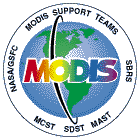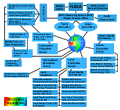
MAIN PAGE
MODIS INFO
INSTRUMENT OPS
Weekly Reports
MODIS History
CALIBRATION
L1B PRODUCT INFO
& STATUS
CONTACTS & STAFF
ON-LINE DOCS
FREQUENTLY
ASKED QUESTIONS
SITE MAP
SEARCH
RELATED LINKS
MCST DICTIONARY
NASA/GSFC Website Privacy and Security Statement, Disclaimer, and Accessibility Certification

MODIS Characterization
Support Team
(MCST)
MODIS MCST Science
Team Meetings
|
|
Terra (PFM) Instrument
Status
Current Status: Science Data ModeMODIS was launched on the EOS Terra spacecraft on Saturday, December 18, 1999 at 18:57 GMT. MODIS Terra "First Light" was achieved when the MODIS Nadir Aperture Door opened on February 24, 2000. The Terra MODIS instrument began taking data using side-A electronics. Current Relative Spectral Response (RSR) tables are available for MODIS Terra (PFM). MODIS polarization tables and information are available for Terra (PFM)" with the following link: ftp://ftp.mcst.ssai.biz/pub/permanent/MCST/MODIS_polarization Detailed operations are documented in the Weekly Reports and the MODIS History links under the Instrument Ops button on this web page. Terra MODIS instrument performance history is documented in Terra MODIS Instrument Performance History. For a complete look at the EOS-AM/Terra mission see http://terra.nasa.gov/. |
Aqua (FM1) Instrument StatusCurrent Status: Science Data ModeMODIS was launched on the EOS Aqua spacecraft on Saturday, May 4, 2002 at 09:55 GMT. MODIS Aqua "First Light" was achieved when the MODIS Nadir Aperture Door opened on June 24, 2002 at 23:22:48 GMT. The Aqua MODIS instrument began taking data using side-B electronics. Current Relative Spectral Response (RSR) tables are available for MODIS Aqua (FM1). MODIS polarization tables and information are available for Aqua (FM1)" with the following link: ftp://ftp.mcst.ssai.biz/pub/permanent/MCST/MODIS_polarization Detailed operations are documented in the Weekly Reports and the MODIS History buttons under the Instrument Ops button on this web page. Aqua MODIS instrument performance history is documented in Aqua MODIS Instrument Performance History. For a complete look at the EOS-PM/Aqua mission see http://aqua.nasa.gov/. |
Terra (PFM) Data ProductsTerra data processing uses L1B Version 5.0.38 (collection
5). |
Aqua (PFM) Data ProductsAqua data processing uses L1B Version 5.0.7 (collection
5). |
NOTE:
MCST has observed an anomaly in the Terra
Band 36 Detector 7 (product order) data for all granules between 2008179.2045
and 2008181.0655 (June 27-29) which can be seen by the striping found
in L1B images from this time period (fill values in L1B product for
this detector). As of granule 2008181.0655 the detector has returned
to it's pre-anomaly behavior and has continued to operate normally
through the present time.
This detector should be considered as inoperable for the indicated
period and the QA LUT will be updated to reflect this change.
We are still investigating to determine the cause of the anomaly. Terra
QA LUT changes are tabulated at http://www.mcst.ssai.biz/mcstweb/performance/terra/terra-nonfunct-dets.html
Responsible Civil Servant:
Dr. Jack Xiong <Xiaoxiong.Xiong.1@gsfc.nasa.gov>
Email mcst-webm@ssaihq.com to report any problem with the MCST Web Pages.
Last Update: July 14, 2008